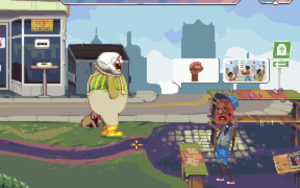Sole and Ciphers
Sole is a game that apparently I kickstarted? I don’t remember doing so, but it’s the sort of thing I kickstart. At any rate, it was released earlier this year, and I’ve played through it now, so I might as well post about it.
It’s what you might call a beauty game — that is, it’s in the same broad genre as Flower, Journey and ABZÛ (and borrows aspects from all three). These aren’t quite walking sims, because you have some minor puzzles to solve and goals to pursue, but the main reason those puzzles and goals exist is that they’re a convenient way to lead you to the more visually impressive parts of the environments. In Sole, you’re a literal light in the darkness, a radiant rolling ball exploring a dark series of caverns and ruins, wreaking restoration in its wake, making plants spring from the earth and causing crystals to start glowing, a convenient way to tell where you’ve been already. The whole thing is a sort of katabasis myth, a journey through the underworld that starts with a long roll downward and ends in flight. It’s very solar. In fact, the Achievement for winning the game is called “Sol”.
The title isn’t just a pun, though. Originally, the designers wanted the game’s dominant feeling to be one of loneliness. But they changed their mind at some point and decided to instead go for the feeling of being lost. I know this much about the designers’ intent because they explicitly talk about it within the game, in luminous runic graffiti that appears when you get close enough to certain walls. Now, these design notes are in a made-up alphabet. There are optional collectibles that reveal the cipher key, one letter at a time, but to my mind, they weren’t really necessary. I’m pretty good at cryptograms. When I found my first runic message, I deciphered it immediately without knowing there was an “easy way” available. But in retrospect, it seems like in doing so I missed out on what the designers had in mind. I was supposed to stare wonderingly at the incomprehensible glyphs, contributing to that sense of being lost. Finding the keys was supposed to be meaningful, a way of making progress toward understanding, not just collectibles for collectibles’ sake — although it would switch over to that for anyone eventually, I suppose, when you’ve found most of the alphabet.
A peculiar thing about deciphering a made-up alphabet: Once you’ve made sense of a few words, you’re not so much deciphering the text as reading it. Nicklas “Nifflas” Nygren, the creator of Knytt and Uurnog, has recently been doing an experiment where he’s been changing his system font to one of his own making, with made-up glyphs, to see if he could learn to read it as fluently as normal letters. As I note in the replies, I can read his script about as well as I can read katakana: haltingly, making mistakes sometimes, but also sometimes recognizing an entire word at a go. And this is something I can’t do with the more usual sort of cryptogram that represents letters with different normal letters. Essentially, it involves convincing myself that the glyphs I’m looking at are just variations on the more familiar ones. A few letters look very much like their standard versions — in both Sole and Nifflas script, “l” is a gimme. Others are close enough that you can swallow the differences: a Nifflas “e” lacks the middle stroke, but it’s a curve that’s open on the right, and that gives it some recognizable e-ness. And in other cases I’ll grasp at straws to fit a glyph into my mind’s conception of a letter, but still manage it somewhat.
I think back to my experiences with Dropsy, which had a cipher alphabet that I somehow completely managed to fail to recognize as a cipher alphabet. Why was this so much less readable to me? Part of it is that you usually see it in smaller snippets — just a word or two on a shop’s door or whatever — and that these are inherently less easily decipherable than a full sentence full of short common words like “the”. Not all of the graffiti in Sole is design notes. Some of it is the equivalent of “Kilroy was here”. Maybe if I had seen some of those first, I would have had something more like the intended experience.
 Comments(0)
Comments(0)